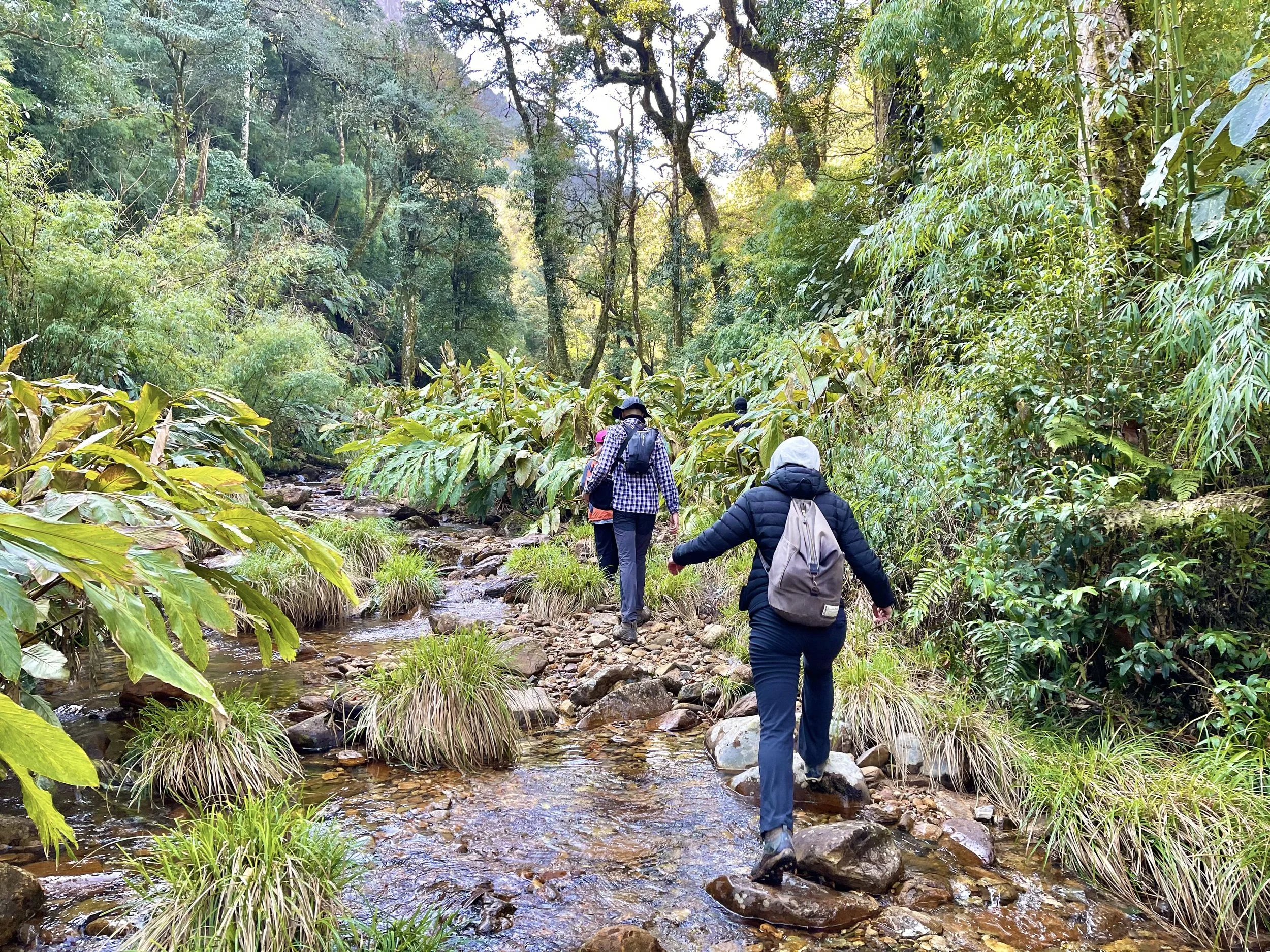
The Twin Waterfalls
Twin Waterfalls Trek in Sapa – Forest Adventure & Hidden Gems
“I took a walk in the woods and came out taller than trees.”
Duration: Half day (approximately 5 hours)
Departure time: flexible am or pm
Physical activity: Moderate
Location: Hoang Lien Son National Park and O Quy Ho Pass
Travel Style: Forest walking and nature.
Connectivity: Wifi - None, Mobile coverage - good.
A Half-Day Forest Adventure with Hidden Waterfalls and Biodiversity
Discover Black Cardamom Plantations, Rare Flora, and Panoramic Mountain Views
Even in an area with exceptional biodiversity and natural beauty, this trek stands out. It takes place high above the terraced rice fields and in the cloud-draped forests that line the foothills of Mt. Fansipan.
Growing under the deciduous canopy, much of this walk passes through the Hmong black cardamom plantations, an essential ingredient in many Vietnamese dishes. Black cardamom was first planted in the Hoang Lien Mountains in the 1990's as a replacement for opium, a banned crop that once helped prop up Indochina’s colonial economy. The national park, meanwhile, is a symbol of postwar Vietnam’s efforts to protect plant biodiversity. Black cardamom, known as thao qua, grows along stream-beds in high-elevation forests, under the canopy of tall trees. As a dried spice, it is used in pho, Vietnam’s ubiquitous noodle soup, and a few other popular dishes.
Avoiding the busier Silver waterfall, this half day trek ventures in to the primary forests of the Hoang Lien Son National
Park. While you’re unlikely to see the primates and bears found in the deep jungle, amphibians, birds and flying squirrels are all feasible sightings on this trek.
The highlights are visits to the Love Waterfall and much less visited Swallow Falls found along a hidden valley with great trees and Rhododendron flowers. With part of the route paved, other sections require crossing streams and scrambling. At certain times of year, it may be possible to forage for edible fruits, shoots and berries together with your local guide.
Although the walk only around 4km, good shoes are essential. Much of the walk takes place at an elevation of around 2000 metres (6500 feet).
There is also the option of visiting the famous road between Sapa and Lai Chau Province. The Tram Ton Pass (also known as O Quy Ho or Heaven’s Gate) is situated on the northern side of Mt. Fansipan, 15km from Sapa. At 1900m, it is Vietnam’s highest mountain pass, and acts as a dividing line between two climatic zones. The lookout points here have fantastic views in clear weather. Even in misty conditions you’ll know you’ve arrived because it’s significantly warmer on the pass than in Sapa: the pass is both a climatic divide and a provincial one, marking the border of Lao Cai and Lai Chau provinces.
Included:
Return transportation
Entrance fees to the Hoang Lien Son National Park
English / Vietnamese speaking ethnic minority guide
Water and fruit
Not Included:
Travel Insurance
Required equipment:
Walking shoes or boots
Waterproof clothing
Eye protection (shades are suitable)
Recommended:
Camera / camera phone (with protection)
Insect spray
Prices - The Twin Waterfalls Half Day Experience
2 people - $45 per person
3 people - $40 per person
4 people - $35 per person
5 people - $32 per person
6 people - $30 per person
Notes:
Be aware that during foggy and rainy periods, trails around Sapa are often muddy and slippery. Walking shoes with good grip are highly recommended. We believe that trekking is all about discovery and access to the most exciting villages may involve steep inclines and clay slopes. This trek usually involves two river crossings. During periods of heavy rainfally, the walk route may be changed to avoid any unnecessary risk.
Part of the experience fee is used as payment for your three host family. You can read more about our Social Responsibility projects here.
Community based tourism (CBT) is a form of tourism where local communities are directly involved in developing, managing, and benefiting from tourism activities within their area. It emphasises community ownership, cultural preservation, and sustainable practices, offering visitors authentic experiences and fostering economic opportunities for residents.
“Do not follow where the path may lead. Go instead where there is no path and leave a trail.”
Please travel with respect. Dress modestly, support local crafts, protect nature, be patient, and stay safe. Connect, learn, and contribute positively during your ETHOS journey. Please refer to our terms for booking conditions for all ETHOS experiences.
We also offer a half day trekking experience in a different valley in Sapa. For more information about our “ Rice Terraces and Waterfalls “ experience, please click here.





























